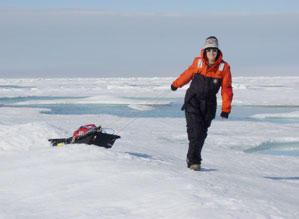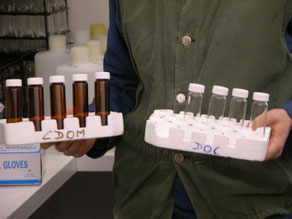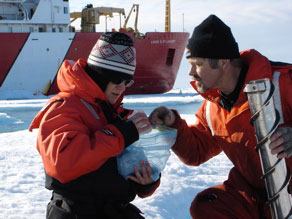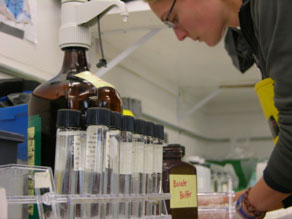Luc RainvilleAugust 18-19, 2007
We are finishing the last of the several CTD lines going from the deep Canada Basin to the continental shelf. After the Banks Island line, Mackenzie line, Barrow line, and the two series of stations near the Northwind Ridge, we were able to occupy one more line on the northeastern side of the Beaufort Sea, towards the Prince Patrick Island (just north of Banks Island). This line had never been sampled before: the ice is usually very compressed and impassable. We have been lucky this year: despite the thick multi-year ice, there are enough leads and open water to navigate around the large floes and take CTD casts at the right bathymetric contours. We are very interested in these dense CTD lines because of the many processes happening at the continental shelves. By and large, the currents in the ocean flow along the bathymetry, and the strongest currents are found along the shelves. These currents play an essential role in transporting freshwater, nutrients, and other tracers. Biological activity is also usually higher in shallower waters - the shelves play a foremost role in the carbon cycle of the ocean - and this signal is exported to the deeper waters. This is precisely what Céline Guéguen, holding a Canada Research Chair at Trent University, is interested in. She studies dissolved organic carbon (DOC) and is particularly interested in colored dissolved organic matter (CDOM), which comes from leaching of humic substances from plants and soil organic matter. CDOM absorbs light in the ultraviolet and visible range, and by measuring the absorption and emission for different wavelengths, Céline is able to figure out the origin of the carbon present in the water. The carbon coming from in-situ production (local biology), river runoff, and shelf processes (biology + ice formation) all have different signatures. Ammonium is another tracer for shelf water. It is produced and released by living organisms. In high-production areas, some of the ammonium in the organic matter floating in the water column is utilized immediately, but most of it reaches the bottom sediments. There bacterial activity can release ammonium back in the water, and it can eventually be exported to the deep interior basin. Kristina Brown, from IOS, is measuring ammonium during this cruise. Following the ammonium signal gives an idea of how the water masses from the shelves reach the interior of the Beaufort Sea. Last updated: October 7, 2019 | |||||||||||||||||||||
Copyright ©2007 Woods Hole Oceanographic Institution, All Rights Reserved, Privacy Policy. | |||||||||||||||||||||






